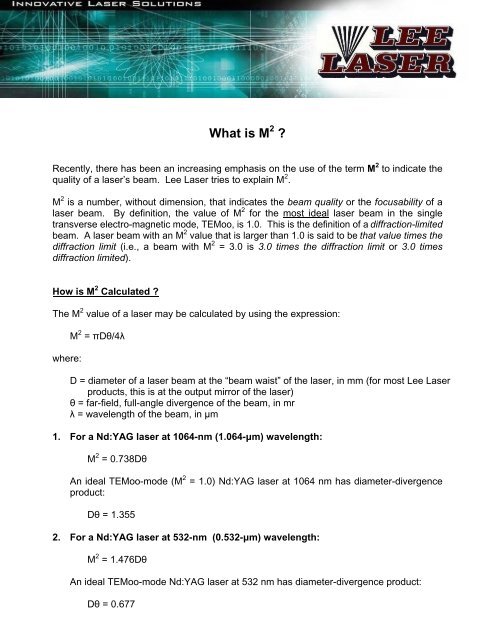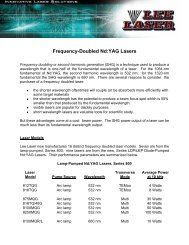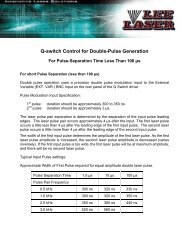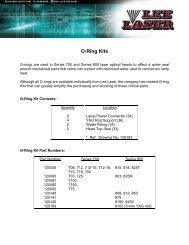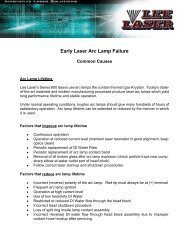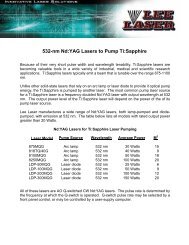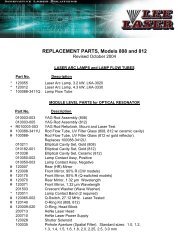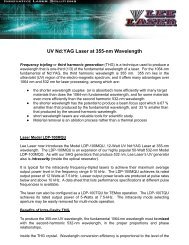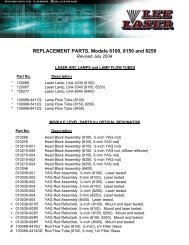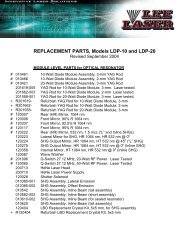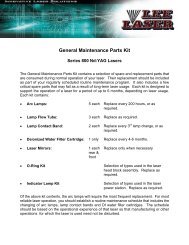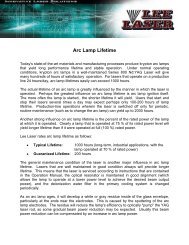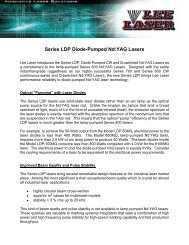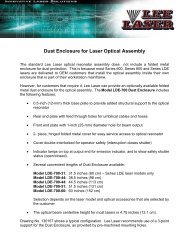What is M2 - Lee Laser, Inc.
What is M2 - Lee Laser, Inc.
What is M2 - Lee Laser, Inc.
You also want an ePaper? Increase the reach of your titles
YUMPU automatically turns print PDFs into web optimized ePapers that Google loves.
<strong>What</strong> <strong>is</strong> M 2 ?Recently, there has been an increasing emphas<strong>is</strong> on the use of the term M 2 to indicate thequality of a laser s beam. <strong>Lee</strong> <strong>Laser</strong> tries to explain M 2 .M 2 <strong>is</strong> a number, without dimension, that indicates the beam quality or the focusability of alaser beam. By definition, the value of M 2 for the most ideal laser beam in the singletransverse electro-magnetic mode, TEMoo, <strong>is</strong> 1.0. Th<strong>is</strong> <strong>is</strong> the definition of a diffraction-limitedbeam. A laser beam with an M 2 value that <strong>is</strong> larger than 1.0 <strong>is</strong> said to be that value times thediffraction limit (i.e., a beam with M 2 = 3.0 <strong>is</strong> 3.0 times the diffraction limit or 3.0 timesdiffraction limited).How <strong>is</strong> M 2 Calculated ?The M 2 value of a laser may be calculated by using the expression:where:M 2 = D /4D = diameter of a laser beam at the beam wa<strong>is</strong>t of the laser, in mm (for most <strong>Lee</strong> <strong>Laser</strong>products, th<strong>is</strong> <strong>is</strong> at the output mirror of the laser)= far-field, full-angle divergence of the beam, in mr= wavelength of the beam, in m1. For a Nd:YAG laser at 1064-nm (1.064- m) wavelength:M 2 = 0.738DAn ideal TEMoo-mode (M 2 = 1.0) Nd:YAG laser at 1064 nm has diameter-divergenceproduct:D = 1.3552. For a Nd:YAG laser at 532-nm (0.532- m) wavelength:M 2 = 1.476DAn ideal TEMoo-mode Nd:YAG laser at 532 nm has diameter-divergence product:D = 0.677
2It should be remembered that the M 2 value of 1.0 for a laser <strong>is</strong> the ideal, theoretical limit. Noactual laser meets th<strong>is</strong> theoretical limit. Only the most soph<strong>is</strong>ticated scientific lasers evenapproach the theoretical limit of 1.0 for M 2 .Why does <strong>Lee</strong> <strong>Laser</strong> not use M 2 ?<strong>Lee</strong> <strong>Laser</strong> prefers not to use the value of M 2 to indicate the beam quality of our laser products.M 2 cannot be measured; it <strong>is</strong> a value that <strong>is</strong> calculated from other parameters that aremeasured. As a practical matter, it <strong>is</strong> much more difficult to use the value of M 2 to determinethe focus potential of a laser, or the focus spot diameter when a laser <strong>is</strong> used with a particularset of beam delivery optics:wheres = 4(M 2 ) f/ Ds = diameter of the beam focus spot, in mf = focal length of the focusing lens, in mmRather, <strong>Lee</strong> <strong>Laser</strong> prefers simply to use the values of beam diameter, D, and beamdivergence, , that we publ<strong>is</strong>h in our specifications data sheets. With these values, thediameter of a beam focus spot may be calculated simply by the expressions:1. Focus Spot Potential of a <strong>Laser</strong>whereors = FDF = the F# of the focus lens (in th<strong>is</strong> case, a beam expander must be adjusted to sothat the beam completely fills the input clear aperture of the focus lens)2. Focus Spot Diameter (when a laser <strong>is</strong> used with a particular set of beam delivery optics)wheres = f 11 = full-angle divergence of the beam as it enters the focus lens (will be different fromif a beam expander <strong>is</strong> used), in mr
M 2 and <strong>Lee</strong> <strong>Laser</strong> Specifications Data Sheets3Specifications data sheets for <strong>Lee</strong> <strong>Laser</strong> products do not state the M 2 values of the lasers.Rather, we state the beam diameter and full-angle beam divergence values that a lasertypically exhibits. Th<strong>is</strong> information <strong>is</strong> much more useful to our customers that must calculatethe beam focus capability of a laser. Th<strong>is</strong> calculation from the M 2 value <strong>is</strong> much more difficult.Furthermore, the value of beam wa<strong>is</strong>t diameter of a laser that <strong>is</strong> needed to calculate M 2 <strong>is</strong> notthe same as the value of beam diameter that <strong>Lee</strong> <strong>Laser</strong> states in our data sheet:1. Beam Diameter for Data Sheet: Actual measured value about 10 inches (25 mm) fromthe output end of the laser.2. Beam Diameter for M 2 Calculation: Th<strong>is</strong> <strong>is</strong> the beam wa<strong>is</strong>t diameter which <strong>is</strong> located atthe reflective surface of the laser output coupler. Because access <strong>is</strong> not possible tomeasure th<strong>is</strong> dimension, it must be calculated from beam diameter measurements thatare taken at different d<strong>is</strong>tances from the output end of the laser.Clearly, <strong>Lee</strong> <strong>Laser</strong> s publ<strong>is</strong>hed value for laser beam diameter cannot be used as the beamwa<strong>is</strong>t value to calculate M 2 .The Benefit of Using M 2<strong>What</strong> <strong>is</strong> the benefit of using the M 2 value of a laser ? Within the laser industry, there ex<strong>is</strong>tssome d<strong>is</strong>agreement about the meaning of beam divergence and beam size. Somecompanies l<strong>is</strong>t in their data sheets only the half angle for beam divergence, and l<strong>is</strong>t only thebeam radius for beam size. Therefore, the mm-mr product that <strong>is</strong> used by many lasermanufacturers does not clearly define the performance of a laser, and for two identical lasersit can differ by as much as a factor of 4.However, the expression of M 2 as defined above <strong>is</strong> universally recognized within the laserindustry. Therefore, M 2 can be a valuable tool when comparing the performance of two lasersthat are manufactured by different companies, or even of two lasers by the same company.


